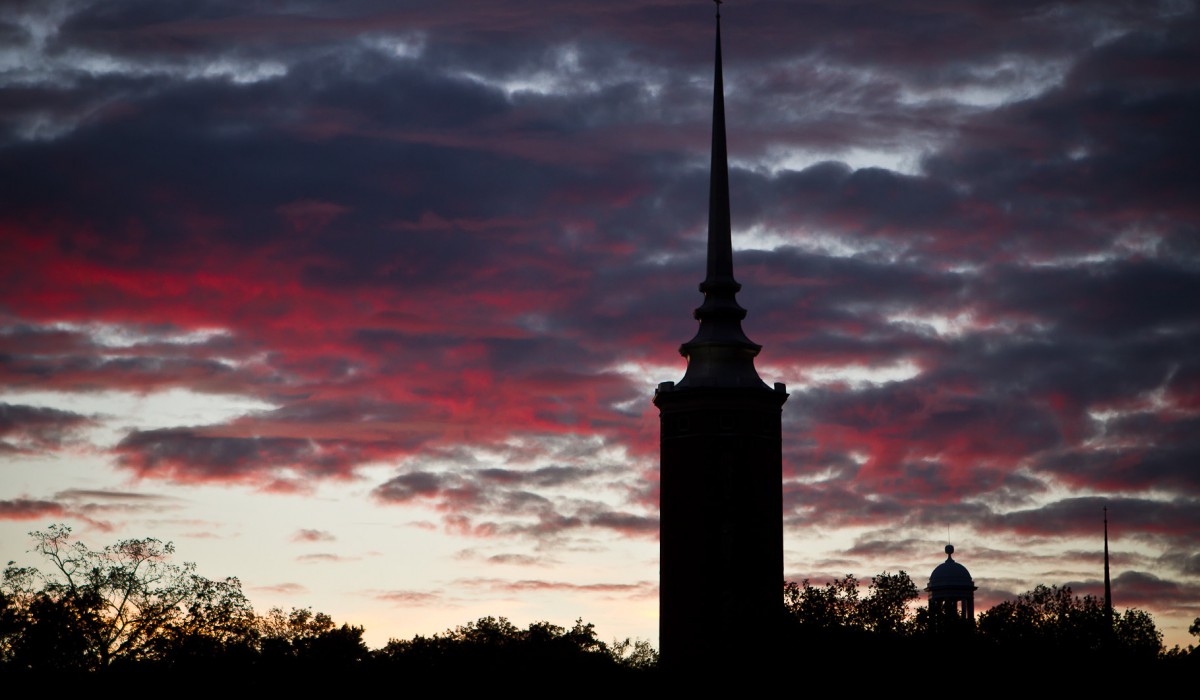 Weaver Chapel is almost exactly as long as it is tall (212 ft. compared to 214 ft.). Its tower is central to the symbolism of the chapel.
Weaver Chapel is almost exactly as long as it is tall (212 ft. compared to 214 ft.). Its tower is central to the symbolism of the chapel.
Weaver was intended as a statement on the integration of faith and learning, and those themes converge in the tower. First the two glass doors at its base contained a sandblasted Tree of Life (on the left) and a Tree of Knowledge (on the right), facing twin sidewalks that ran all the way to Woodlawn. Once inside the entrance, doors to the right took on into the library, while the stairway to the left took one to the chapel.
Those symbols were lost over time: the Tree of Knowledge was broken and the Tree of Life moved to the archives in the library. The twin sidewalks were re-routed. And the entrance to the library was sealed off in the library expansion of the early 1980s. And on the inside of the library doors, the university seal was covered with carpet.
But some symbols are harder to eliminate. One of my favorite questions to ask juniors or seniors is "Who are the statues on Weaver Tower?" The three statues facing west, toward the then campus, represent the Lutheran religious heritage: Paul the Apostle, Augustine, and Martin Luther. Paul's epistles were crucial to Luther's theology. Luther's theology is broadly understood as "Augustinian," and he was a member of an Augustinian order of monks. So the choice of Augustine was natural enough, especially in the 1950s.
On the other side, facing east, the choices represent the arts and learning, and they are a bit more complicated. J. S. Bach, the great composer and a Lutheran was a natural choice. John Milton seemed to them another natural choice, as the greatest of English-language poets -- a view common at the time though hardly the consensus today.
But the third statue is harder to explain. To be sure, Gottfried Leibniz was a polymath and contributed to all sorts of fields. He vies, reasonably, with Newton as a founder of calculus and is still taught in philosophy departments like ours. Still, unlike Milton and Bach, he was not particularly religious, and his selection seemed a bit, well, random. Eventually a letter from the committee that chose the six names yielded an explanation: Leibniz was chosen because he was "less objectionable than the remaining alternatives."
OK, that is not much of an explanation, or an endorsement. But then, we are talking about a committee.
About The Project
With Wittenberg now celebrating its 175th year, and the University unable to hold regular in-person classes as a result of the COVID-19 pandemic, Professor of History Thomas T. Taylor has started circulating several pieces on Wittenberg's history. Some originated in earlier series, either This Month in Wittenberg History or Happy Birthday Wittenberg. Others have their origin in the Wittenberg History Project or in some other, miscellaneous project. Sincerest thanks to Professor Taylor for connecting alumni, faculty, staff, and students through a historic lens.

